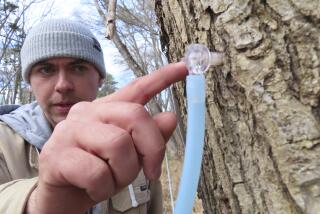Warm Spring Spells Disaster : Maple Syrup Producers Face Sour Year
- Share via
MONTPELIER, Vt. — Spring is coming early in Vermont for the second year in a row, raising the prospect of bitter times for the state’s maple sugar producers.
“We’re a little over half of last year, and that was a bad year,” said Wilson Clark, president of the Vermont Maple Sugar Producers’ Assn.
Vermont, the nation’s leading maple sugar producer, last year put out about 345,000 gallons of maple syrup, contrasted with an annual average of 500,000 gallons. This year, the state will be lucky to produce 300,000 gallons, Clark and other producers said.
Clark, who started sugaring on his family’s Pawlet farm at age 12 in 1944, said 1987 may rank second only to 1945 among the worst years he has ever seen.
He said 1945 “was considered the disaster of the century” and that 1987 “probably will be close to that.
End of Season Near
“We’re fast approaching the end (of the season). We’ll probably be done in two or three more days.”
With the prime syrup-producing states of Vermont, New York, New Hampshire and the province of Quebec all reporting an off year, prices are expected to take a sharp jump for the second year in a row.
Harry Morse of the Morse Farm in Montpelier said he feared that another price increase on top of last year’s jump of 30% to 50% might cut down consumers’ willingness to pay.
The price for a gallon of maple syrup might climb as high as $60 this year, Morse said. “I’m not even selling gallons this year. It’s just too much to ask,” he said. Half-gallon containers were going for $26.
Clark too said he was worried about asking too much. “It could be bad for the industry,” he said.
Weather Wrong
The decline in production is caused by the absence of several weather factors needed to produce a good flow of sap, sugar makers said.
Ideal conditions bring freezing temperatures for eight hours or more during the night, with warmer temperatures during the day. This causes the sap to congeal in the tree overnight and then run like a spring flood in the morning thaw.
The sap is boiled down into syrup, with about 35 to 40 gallons of the tree’s juices “sugaring down” to one gallon of the pancake lover’s nectar.
When buds begin to appear on the tree, the syrup loses its sweet flavor and the sugaring season is over.
“Dismal,” was the way Elizabeth Corell, head of marketing and promotion for the New Hampshire Department of Agriculture, described the maple syrup season in her state. She said New Hampshire was expected to produce about 30% of its average annual production of 85,000 gallons.
Acid Rain Blamed
Maple growers in Quebec blame acid rain for killing forests. Last year, a farmers’ union sent a bill to the Quebec and Canadian governments seeking $87 million (Canadian) to compensate for such losses.
The Proctor Maple Research Farm in Underhill, which is affiliated with the University of Vermont, has been researching a possible link between acid rain and the decline in maple production.
“We have no scientific proof right now,” said Ed Lidster, a research technician at the farm. But he said the preliminary research has shown that airborne pollutants that return to Earth in the form of acid precipitation “might reduce the maple trees’ vigor, which would end up reducing production.”
Lidster said the decline in production over the last two years “is definitely due to the warm weather. We just haven’t had the nightly freezes that we need.”
More to Read
Sign up for Essential California
The most important California stories and recommendations in your inbox every morning.
You may occasionally receive promotional content from the Los Angeles Times.












